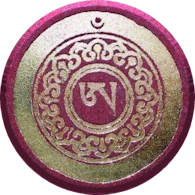
Akong Rinpoché Establishing Buddha-Dharma
Part Seventeen: Establishing Tap-Lam, the Long Retreats ....Part 1
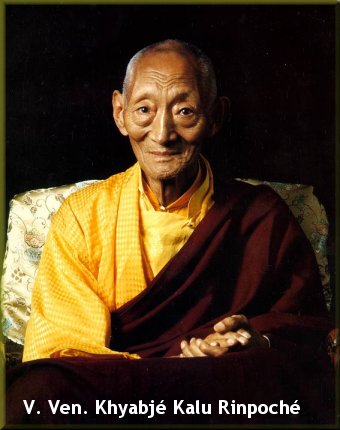 As early as 1973, Akong Rinpoché started discussing, with Kalu Rinpoché whom Rinpoché wanted to lead it, the possibility of creating a three-year retreat in Samye Ling. However, soon after that the disciples of Kalu Rinpoché in France bought the Chateau de Pleige, in Burgundy, and by 1975 were putting pressure on Kalu Rinpoché to establish his European retreat there. The discussions about possible
location eventually centred around the retreat candidates' opinions about how to cost the retreat. Having already some years experience of Samye Ling, Akong Rinpoché was quite lucid about the probable construction and overall running costs of such a retreat and hence the cost per person involved, i.e. the money each participant would have to raise, one way or another, in order to join. Denys Esseyric and the French however came up with very low estimates, based on simple calculations of everyone living off brown rice and
of a "self-build" using cheapest materials. Kalu Rinpoché felt obliged to go along with these estimates (which inevitably turned out completely unrealistic once the French retreat actually happened) as most of his candidates for retreat were, friends of Denys, one of his chief disciples and his interpreter.
As early as 1973, Akong Rinpoché started discussing, with Kalu Rinpoché whom Rinpoché wanted to lead it, the possibility of creating a three-year retreat in Samye Ling. However, soon after that the disciples of Kalu Rinpoché in France bought the Chateau de Pleige, in Burgundy, and by 1975 were putting pressure on Kalu Rinpoché to establish his European retreat there. The discussions about possible
location eventually centred around the retreat candidates' opinions about how to cost the retreat. Having already some years experience of Samye Ling, Akong Rinpoché was quite lucid about the probable construction and overall running costs of such a retreat and hence the cost per person involved, i.e. the money each participant would have to raise, one way or another, in order to join. Denys Esseyric and the French however came up with very low estimates, based on simple calculations of everyone living off brown rice and
of a "self-build" using cheapest materials. Kalu Rinpoché felt obliged to go along with these estimates (which inevitably turned out completely unrealistic once the French retreat actually happened) as most of his candidates for retreat were, friends of Denys, one of his chief disciples and his interpreter.
With the pressure off a rapid appearance of a long-term retreat in Scotland, Akong Rinpoché decided to send his two main disciples of the time—the author and Katia—into Kalu Rinpoché’s retreat in France and we were duly sent away to France to find the money and prepare, in every way, for retreat. In 1976, Akong Rinpoché visited France and we had the pleasure of being his main assistants as he went to the new land in the Dordogne and to the Kagyu Ling centre at the Chateau de Pleige. He had gone to Dordogne to visit Gendun Rinpoché and Jigme-la, recently sent there by the Gyalwang Karmapa as caretakers for his new site. He very much enjoyed spending time with Gendun Rinpoché, who was a very impressive master who had spent much of his life in solitary retreat. The Dordogne land was in a very early stage of development and although it had the ideal retreat-master present, it would obviously be some time before it could be up-and-running as a place of retreat. Nevertheless the rural setting made it an obvious candidate. In fact, Gendun Rinpoché’s retreats started not in the donated land of Dhagpo Kagyu Ling but relatively nearby in 1983, at Le Bost, following the donation of land there by Arnaud Desjardins.
Our own personal plans—well under way—for retreat in Pleige were brought to an abrupt halt when two Canadian disciples of Kalu Rinpoché came to Pleige and begged him to be included in the retreat there. As all the retreat places were already filled, Kalu Rinpoché spoke with Akong Rinpoché and then called us in, to ask us if we would not mind terribly postponing our retreat so that his own, very devoted and long-term, disciples could join their camarades. There is only one answer to such a question!
This lack of openings in the Kalu retreat was one factor in Akong Rinpoché realising that he should push ahead with a separate retreat in Samye Ling. He was very consoling to us about this sudden aborting of our plans for the coming years and promised us that we would be able to enter long retreat as soon as it became possible in Samye Ling. He observed very carefully all what was happening in Pleige, where the future retreaters had gathered, and he learned much from it.
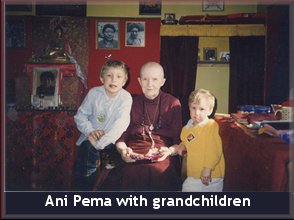 On a hilltop several hundred metres to the south of Samye Ling was an architect-designed, seven-sided property built for a former NASA scientist, James Heath. Appropriately, it was named Sevens. Mr Heath himself did not reside there much himself in the early 70s and it was mainly occupied by his wife Mary, their child and a child-carer, living in an annexe. When it came on the market in the
early 1970s, it was purchased as a personal dwelling by one of Akong Rinpoché’s earliest UK friends and disciples, the nun Ani Pema, formerly Josie Wechsler, who very generously bought it with a life-rites arrangement for her with Samye Ling, concerning the main house, and with Samye Ling having immediate use of the land and annexe. Ani Pema had previously owned a flat in a fashionable London mews: a place visited by Trungpa Rinpoché, Akong Rinpoché and Chime Rinpoché in the mid 60s. She wanted to spend the last
part of her life as a nun in Samye Ling, living independently for as long as her mobility allowed. She lived in Sevens for some years and then moved into a room in Johnstone House.
On a hilltop several hundred metres to the south of Samye Ling was an architect-designed, seven-sided property built for a former NASA scientist, James Heath. Appropriately, it was named Sevens. Mr Heath himself did not reside there much himself in the early 70s and it was mainly occupied by his wife Mary, their child and a child-carer, living in an annexe. When it came on the market in the
early 1970s, it was purchased as a personal dwelling by one of Akong Rinpoché’s earliest UK friends and disciples, the nun Ani Pema, formerly Josie Wechsler, who very generously bought it with a life-rites arrangement for her with Samye Ling, concerning the main house, and with Samye Ling having immediate use of the land and annexe. Ani Pema had previously owned a flat in a fashionable London mews: a place visited by Trungpa Rinpoché, Akong Rinpoché and Chime Rinpoché in the mid 60s. She wanted to spend the last
part of her life as a nun in Samye Ling, living independently for as long as her mobility allowed. She lived in Sevens for some years and then moved into a room in Johnstone House.
Akong Rinpoché installed Sevens as a residence either for himself or for visiting rinpochés and, among other things, started building up a large collection of Tibetan texts there. Besides this seven-sided house, designed as a beautiful residence for a couple, there was the small bungalow staff annexe and some land. Rinpoché had, from the start, ear-marked this land as the best site for a future retreat and decided that the bungalow annexe would become a much-needed, shorter-term, retreat centre, which it soon did. Because of the nature of the retreats there—several months for the likes of the Mahamudra preliminaries—he wanted it to be confined to one sex of occupant. It became the men’s retreat. There being no corresponding, dedicated women’s retreat, ladies had to do their retreats in single rooms or other spaces in Samye Ling: attics or the small huts by the river that had served as retreat-huts since the start. Thus when Katia and I did a three-month retreat in winter 1975 to finish our Guru-Yoga practice, the author was comfortably installed in the peace and quiet of Sevens, now renamed Pureland , while Katia was confined to a very noisy room in the “New Building”.
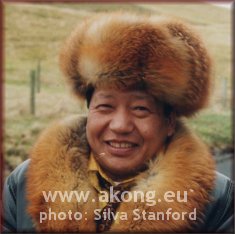 I would like to add a nice, anecdotal story here, concerning that retreat and so typical of Rinpoché. A couple of months into the retreat, I was having a difficult time with some points, not to mention the fact that the heating had been broken for several days and room temperature was barely above zero, with thick snow on the hillsides. I had sent a note asking for Rinpoché to visit and
give advice. As he often did (these were early days and I did not know this at the time), he “let me stew” for a couple of days before coming up. He knew that, by doing that, people either found their own answers or else the situation really ripened to become much more clearly defined. Thus, one morning, I saw this figure, looking like Dr Zhivago, trudging up through the snow, wearing a full-length black cloak, like those worn by European Counts going to the opera, with a crimson lining flashing from time to
time, and with a large, fox-fur chapka on his head. As the person approached, I saw it was Rinpoché, with a huge smile on his face. The cloak had been a recent present, hand-made by Ani Pema. He came into the room, sat down and asked me what was the matter. I gave him a detailed account. He sat, smiling cheekily, for a while and then just said, “Lovely view!”, nodding his head to the window, outside which the rabbits were hopping in the snow. Then he simply got up and left.
I would like to add a nice, anecdotal story here, concerning that retreat and so typical of Rinpoché. A couple of months into the retreat, I was having a difficult time with some points, not to mention the fact that the heating had been broken for several days and room temperature was barely above zero, with thick snow on the hillsides. I had sent a note asking for Rinpoché to visit and
give advice. As he often did (these were early days and I did not know this at the time), he “let me stew” for a couple of days before coming up. He knew that, by doing that, people either found their own answers or else the situation really ripened to become much more clearly defined. Thus, one morning, I saw this figure, looking like Dr Zhivago, trudging up through the snow, wearing a full-length black cloak, like those worn by European Counts going to the opera, with a crimson lining flashing from time to
time, and with a large, fox-fur chapka on his head. As the person approached, I saw it was Rinpoché, with a huge smile on his face. The cloak had been a recent present, hand-made by Ani Pema. He came into the room, sat down and asked me what was the matter. I gave him a detailed account. He sat, smiling cheekily, for a while and then just said, “Lovely view!”, nodding his head to the window, outside which the rabbits were hopping in the snow. Then he simply got up and left.
Following the Pleige episode concerning the long retreat, Pureland was back on the agenda for the Samye Ling version. 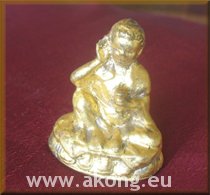 One day, Akong Rinpoché suggested that he and I walk the land there to find the best spot for building a retreat. An unusual and strange thing happened. As we walked around, we stopped on one spot, very near Sevens, which had a good feel. We were standing, admiring the view
over the valley, when Rinpoché looked down and then stooped to pick something up from the grass. It was a gilded statue of Milarepa! Moreover, it was one that had belonged to me and that I had placed on the shrine in Samye Ling in 1973, when the Gyalwang Karmapa conferred the Milarepa empowerment, so that it would be blessed. The statue was one of a limited number (twenty, I believe) of copies of one made of Milarepa, during Milarepa’s lifetime, and owned by Trungpa Rinpoché as one of the Trungpa relic-treasures.
I had gilded it myself. Unfortunately for me, it had disappeared immediately after the empowerment and I had assumed it to have been stolen. And now, inexplicably, there it was, perhaps having been dropped accidentally in the grass by the person who had “borrowed” it, while out for a walk, some six years earlier. It was unmistakably my statue, recognisable by my poor gilding. We will never know the whole story of how it got there. Akong Rinpoché took the finding of it as an auspicious sign that the men’s retreat
should be built there. The women’s retreat would be built as a modification of, and extension of, the bungalow annexe at Sevens. When the building work started, a year or so later, and the land was excavated for foundations, a natural spring welled forth on that very same spot where the Milarepa statue was found, further convincing Rinpoché that it was the right place.
One day, Akong Rinpoché suggested that he and I walk the land there to find the best spot for building a retreat. An unusual and strange thing happened. As we walked around, we stopped on one spot, very near Sevens, which had a good feel. We were standing, admiring the view
over the valley, when Rinpoché looked down and then stooped to pick something up from the grass. It was a gilded statue of Milarepa! Moreover, it was one that had belonged to me and that I had placed on the shrine in Samye Ling in 1973, when the Gyalwang Karmapa conferred the Milarepa empowerment, so that it would be blessed. The statue was one of a limited number (twenty, I believe) of copies of one made of Milarepa, during Milarepa’s lifetime, and owned by Trungpa Rinpoché as one of the Trungpa relic-treasures.
I had gilded it myself. Unfortunately for me, it had disappeared immediately after the empowerment and I had assumed it to have been stolen. And now, inexplicably, there it was, perhaps having been dropped accidentally in the grass by the person who had “borrowed” it, while out for a walk, some six years earlier. It was unmistakably my statue, recognisable by my poor gilding. We will never know the whole story of how it got there. Akong Rinpoché took the finding of it as an auspicious sign that the men’s retreat
should be built there. The women’s retreat would be built as a modification of, and extension of, the bungalow annexe at Sevens. When the building work started, a year or so later, and the land was excavated for foundations, a natural spring welled forth on that very same spot where the Milarepa statue was found, further convincing Rinpoché that it was the right place.
.....this narrative continues: Establishing Tap-Lam, the Long Retreats: Part Two
